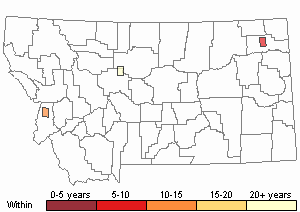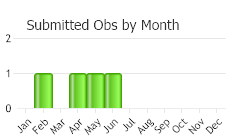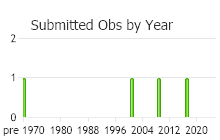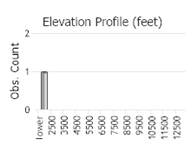View in other NatureServe Network Field Guides
NatureServe
Montana
Utah
Wyoming
Idaho
Wisconsin
British Columbia
South Carolina
Yukon
California
New York
Hooker's Physcomitrium Moss - Physcomitrium hookeri
General Description
Plants: Growing in open or closely-packed tufts (Flowers 1973), small, pale green or occasionally brown. Stems 1-3 mm (FNA 2007), solitary or sometimes forked once or twice (Flowers 1973).
Leaves: Ovate or oblong-ovate, plane or concave, occasionally hood-shaped, upper leaves 2-2.5(-3) mm, much shriveled when dry (FNA 2007), spreading expansively when moist; apex acute or tapering to a point (Flowers 1973); margins not noticeably bordered (Lawton 1971), smooth, although swollen cells in the upper portion may cause unevenness; costa single, ending at the apex or just below (FNA 2007).
Leaf Cells: Distal laminal cells 4- to 6-sided (FNA 2007), with fine walls; lower laminal cells elongated (Lawton 1971).
Phenology
Capsules ripen in spring (FNA 2007).
Diagnostic Characteristics
P. hookeri has smooth margins (sometimes uneven distally but not truly toothed), unlike the other members of Physcomitrium, which possess toothed leaves (FNA 2007).
Range Comments
Uncommon. Endemic to North America (Crum and Anderson 1981). Found in the west from AB s to UT; including KS, NE, IA, MN and ON in the central region; and known from ON, OH and NY in the east (FNA 2007). In Montana: Carter, Cascade, Fallon, and Ravalli Counties (Elliott 2016).
Observations in Montana Natural Heritage Program Database
Number of Observations: 4
(Click on the following maps and charts to see full sized version)
Map Help and Descriptions
Relative Density

Recency



 (Observations spanning multiple months or years are excluded from time charts)
(Observations spanning multiple months or years are excluded from time charts)
Habitat
Wet soil (FNA 2007).
Reproductive Characteristics
Autoicous or sometimes polygamous. Seta (1-)2-4(-6) mm tall. Capsule 0.8-1.5 mm, protruding slightly from or well beyond the tips of the perichaetial leaves, egg-shaped when young, eventually becoming pear- or bell-shaped; neck short, mostly well-defined, usually furrowed when dry (FNA 2007); operculum with an apiculous (Lawton 1971).
References
- Literature Cited AboveLegend:
 View Online Publication
View Online Publication Crum, H.A. and L.E. Anderson. 1981. Mosses of Eastern North America. 2 volumes. Columbia University Press, New York. 1328 pp.
Crum, H.A. and L.E. Anderson. 1981. Mosses of Eastern North America. 2 volumes. Columbia University Press, New York. 1328 pp. Elliott, J.C. and A.K. Pipp. 2018. A Checklist of Montana Mosses (1880-2018). Updated 3 January, 2020. Montana Natural Heritage Program, Helena, Montana. 73 pp.
Elliott, J.C. and A.K. Pipp. 2018. A Checklist of Montana Mosses (1880-2018). Updated 3 January, 2020. Montana Natural Heritage Program, Helena, Montana. 73 pp. Flora of North America Editorial Committee, eds. 2007. Flora of North America North of Mexico. Volume 27. Bryophytes: Mosses, Part 1. Oxford University Press, Inc., NY. xxi + 713 pp.
Flora of North America Editorial Committee, eds. 2007. Flora of North America North of Mexico. Volume 27. Bryophytes: Mosses, Part 1. Oxford University Press, Inc., NY. xxi + 713 pp. Flowers, S. 1973. Mosses: Utah and the West. Brigham Young University, Provo, Utah. 567 p.
Flowers, S. 1973. Mosses: Utah and the West. Brigham Young University, Provo, Utah. 567 p. Lawton, E. 1971. Moss Flora of the Pacific Northwest. Hattori Botanical Laboratory. Japan: Yamabuki-cho, Shinjuku-ku, Tokyo. 362 pages plus appendices.
Lawton, E. 1971. Moss Flora of the Pacific Northwest. Hattori Botanical Laboratory. Japan: Yamabuki-cho, Shinjuku-ku, Tokyo. 362 pages plus appendices.
- Additional ReferencesLegend:
 View Online Publication
View Online Publication
Do you know of a citation we're missing? Elliot, J. C. 1993. Second checklist of Montana mosses. Unpublished report. U.S. Forest Service, Region 1. Missoula, MT. 45 pp.
Elliot, J. C. 1993. Second checklist of Montana mosses. Unpublished report. U.S. Forest Service, Region 1. Missoula, MT. 45 pp. Lawton, E. 1971. Keys for the Identification of the Mosses on the Pacific Northwest. Reprinted from 'Moss Flora of the Pacific Northwest'. Published as Supplement No. 2 of the Journal of the Hattori Botanical Laboratory. Nichinan, Miyazaki, Japan. 66 pp.
Lawton, E. 1971. Keys for the Identification of the Mosses on the Pacific Northwest. Reprinted from 'Moss Flora of the Pacific Northwest'. Published as Supplement No. 2 of the Journal of the Hattori Botanical Laboratory. Nichinan, Miyazaki, Japan. 66 pp.
- Web Search Engines for Articles on "Hooker's Physcomitrium Moss"





